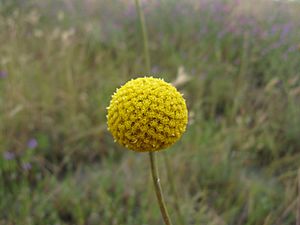Pycnosorus facts for kids
Quick facts for kids Billy buttons |
|
|---|---|
 |
|
| Pycnosorus globosus | |
| Scientific classification | |
| Kingdom: | |
| (unranked): | |
| (unranked): | |
| (unranked): | |
| Order: | |
| Family: | |
| Tribe: |
Gnaphalieae
|
| Genus: |
Pycnosorus
|
Pycnosorus is a group of six types of plants in the daisy family, Asteraceae. They are often called billy buttons or drumsticks. These plants can be annual (grow for one year) or perennial (grow for many years). They are herbs or small shrubs. They have round or cylinder-shaped "flowers" that look like small balls. Each "flower" can have up to 200 tiny daisy-like parts.
Each of these "flowers" is actually a pseudanthium. This means it's a cluster of many small flowers that look like one big flower. Each tiny flower part is called a floret. There are usually three to eight florets in each cluster. These florets are surrounded by special leaves called bracts. The petals of each floret are joined together to form a small tube. The florets and their surrounding bracts are usually yellow or golden-yellow.
What Billy Buttons Look Like
Plants in the Pycnosorus group are herbs that can live for one year or many years. Their leaves get smaller as you go up the stem. The leaves at the bottom of the plant usually dry up first.
The "flowers" of these plants are arranged in oval or round heads. Each head can have between 40 and 200 smaller flower-like parts. Each of these smaller parts is made up of three to eight tiny flowers, called "florets." The florets and the special leaves (bracts) around them are yellow or golden. Each tiny flower has five petals that are joined together like a tube.
After pollination, the flowers turn into silky achenes. An achene is a small, dry fruit that contains one seed. These achenes have a ring of feathery bristles, which helps them spread their seeds.
There's another plant group called Craspedia that is also known as "billy buttons." The main difference is how their flowers are attached. Craspedia flowers grow on small stalks. Pycnosorus flowers are attached directly to the plant's main stem, without a stalk. Scientists are still studying if these two groups are very closely related.
Naming Billy Buttons
The group of plants called Pycnosorus was first officially described in 1837. This was done by a scientist named George Bentham. He wrote about it in a book about plants from Australia. Bentham chose Pycnosorus globosus as the main example, or type species, for this group.
The name Pycnosorus comes from two Ancient Greek words. Pyknos means "dense" or "thick." Soros means "heap." This name likely describes how the flowers grow closely together in a dense, round shape.
Here is a list of the six types of Pycnosorus plants that are recognized in Australia:
- Pycnosorus chrysanthus – also known as golden billy-buttons
- Pycnosorus eremaeus
- Pycnosorus globosus – often called drumsticks
- Pycnosorus melleus
- Pycnosorus pleiocephalus – sometimes called soft billy-buttons
- Pycnosorus thompsonianus
Where Billy Buttons Grow
All six types of Pycnosorus plants are found only in Australia. You can find them in all Australian states except Tasmania. Most of these plants like to grow in heavy soils, which are often rocky.
See also
 In Spanish: Pycnosorus para niños
In Spanish: Pycnosorus para niños

